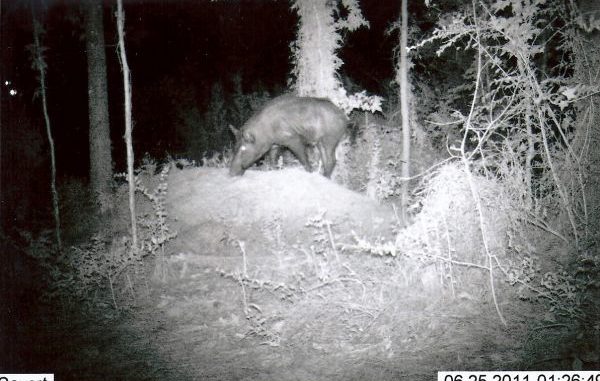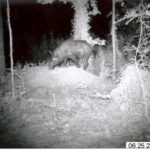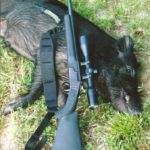
Summertime isn’t all about fishing
I mentioned last month that the hogs were finally beginning to show up at the bait sites and I was making plans to put some pork in the freezer.
Last summer at this time I wrote about the success I had with hunting hogs with solar lights in July. Well, they are back and appear to be really hungry. Last year I killed four during the month of July. From the action that I encountered the first week of July this year, it appears that I may break my record.
Now some would say that July is not the time to be hunting, but when the hogs are moving and looking for food, it is time to hunt.
But when hunting during these hot weather months, one has to be prepared. The key is to let technology (trail cameras) do the scouting so you are not sitting in stands waiting for something that is not on your schedule.
So far, the hogs have been hitting the bait sites early in the morning, right at sunrise and right before dark, when it has cooled down and is a little more comfortable for hunting.
Another key is to be prepared to clean the hog and get it on ice or in the cooler once it is dead. I use the large igloos and buy ice in advance so time is not wasted going to the store. The John Deere is used to get the animal from the woods to the cleaning rack (way too hot to be dragging out game) quickly.
I was again using my automatic shotgun, shooting buckshot and slugs. My first encounter was right at dark, with several hogs on the bait.
I eased in and, at 20 yards, cut loose with two shots, but came up empty.
While making the rounds to check the cameras early one morning a few days later, I saw a big boar running down the neighbor’s field heading toward me. The hog changed direction and walked broadside to me at 40 yards.
It was just too far with the shotgun, and I watched it enter the woods. I thought it might be heading to the bait site I just left and slipped back to it and waited, but the hog was a no-show.
On the way back through woods I started picking up a strong smell. I took a few steps and looked to my right and saw the large hog rooting in the privet brush about 20 yards away.
When I raised the shotgun, the hog bolted away from me and I fired a shot, the hog squealed and kept crashing through the woods. I found a little blood, but the trail ended quickly and after an hour of looking I decided the hog had been hit but I wasn’t going to find it.
Another suggestion would be to pack enough gun, so a quick trip to Baton Rouge was in order to get the .444.
A few days later, the cameras pointed out a hog that was visiting one site at dawn, so at 5:30 a.m. I was heading to that site.
I checked the scope to be sure it was on low power and in focus for my eyes. I rounded the corner of the big food plot and put a large willow oak tree in front of me to shield my approach. I figured I was close enough, and eased to my left and was pleasantly surprised to see a black hog standing broadside; the rifle roared and the hog dropped, kicked its back legs and slid into the wallow that is associated with the bait.
I went back to the camp, cranked up the tractor and made the retrieve: a nice 125-pound boar. I hosed it off for the photo shoot, and then cleaned and dropped it in the cooler.
A few days later it was at the butcher shop with directions for chops and sausage. The last photo of this hog alive was at 5:45 a.m., about five minutes prior to my shot.
I re-baited all sites before leaving, and then left for the weekend. Returning on Monday, I was pleased to see that several different hogs were at the two bait sites.
I have heard that hogs will not return to the bait site once one is killed, but I find that not to be true. These hogs do not appear to be the least disturbed by the hunting activity. I think the main reason is that during July the natural food is scarce and they are hungry. Deer hunters have not cranked up their feeders in the surrounding areas, and all the mast from last year is gone. There are no forage crops in the area, only pasture land and woods, so once they find a regular source of good feed they become constant visitors.
There was another black hog at the mound site, and it was there shortly after 9 p.m. so I decided to make an evening hunt, and felt certain I was going to get a shot. I was a little late in leaving the camp, and at 8:45 was approaching the mound.
The lights were on, but I did not see any hog moving around. However, I kept slipping in very slowly and cautiously; the brush is very thick on one side of the site, and I thought a hog could be right there checking out things.
As I approached the site, using a big pine to shield me, I noticed movement by the pine and suddenly realized it was a hog rooting up the corn. The solar lights were shining directly in its face, so I guess he did not notice me or perhaps it was just real hungry.
I raised the .444 standing about 8 feet away fro the hog, put the crosshairs on the head and fired. This pig also dropped in its tracks; the bullet hit right behind the head and passed through the neck, breaking the spine.
Within an hour this pig was on ice, awaiting processing. It was very similar in size to the first: maybe 150 pounds, probably a young 2-year-old.
Two days later, I checked the cameras and once again there were hogs at both sites: another big black one at the site where the second one had just been killed, and a big black-and-white mottled hog at the wallow site that is coming right at daylight and a huge boar that has a midnight agenda at the same location.
While most of the deer hunters are fishing I am having a heck of a time hunting hogs and filling up the freezer with some delicious pork.
With the deer season just around the corner, bow season starts in September for you Southwest Louisiana hunters, so August is the month to start getting things ready for the deer season.
Stand locations, food plots, and tuning up the gun and bow are some of the more-important jobs to get done.
I am seeing oaks with acorns, and pecans and persimmons with fruit, so this may be another season with lots of native food for the deer. So do some scouting for the mast trees and be prepared to hunt these foods rather than the traditional feeders and food plots.
The clear cutting that was done on the 60-acre tract I hunt has produced a ton of native browse this spring and summer, and deer activity is high. The key to good deer hunting is to keep the habitat productive.
A deer management seminar will be held on Aug. 2 at the Wildlife and Fisheries building on Quail Drive in Baton Rouge. It would be a good time to hear some current management information prior to the 2012 season.




